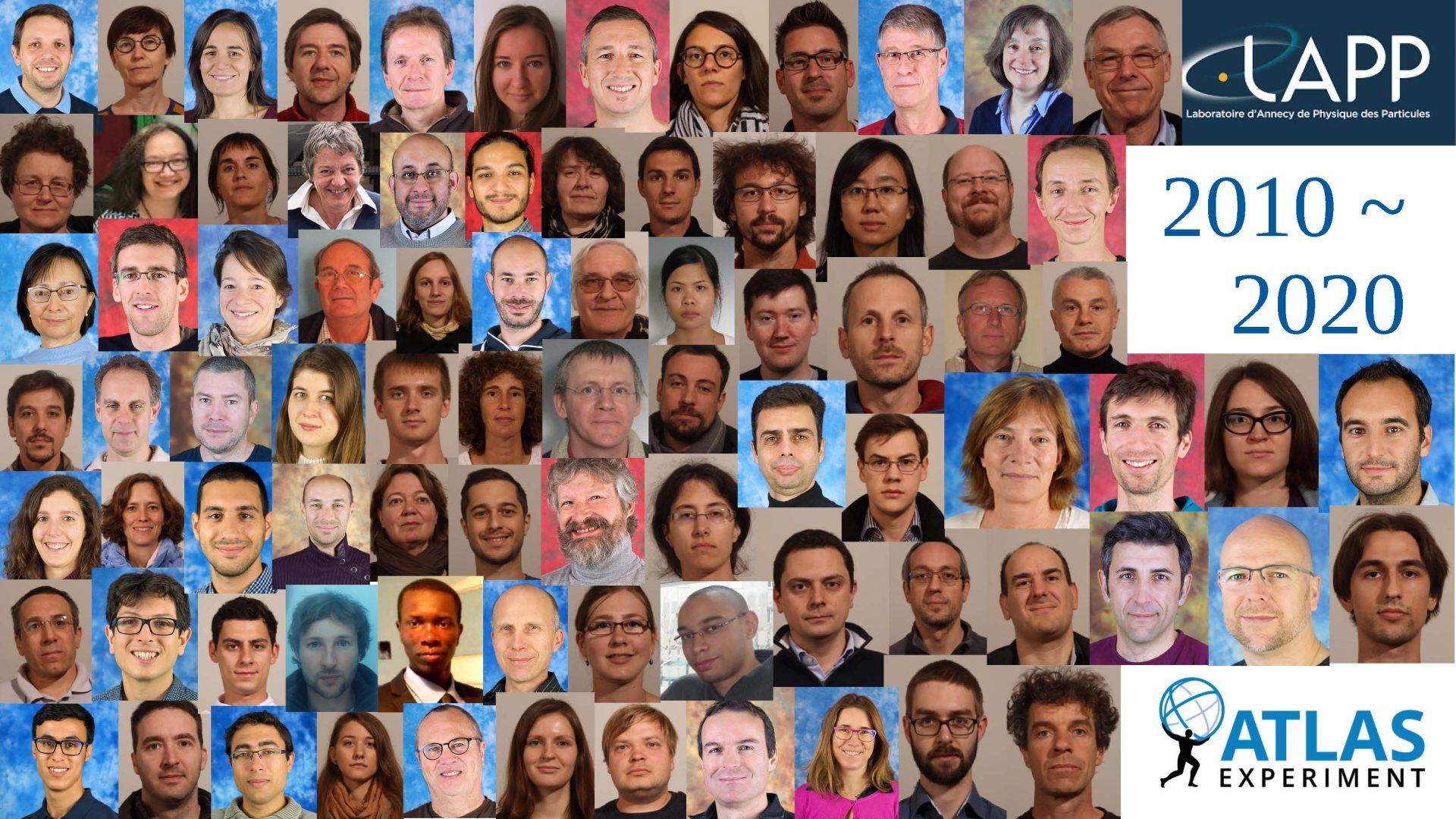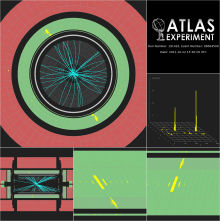Ten years of ATLAS physics at LAPP
On 30th of March 2010, the Large Hadron Collider at CERN provided the first proton-proton collisions with a total energy of 7 TeV, becoming the highest energy collider in the world. The ATLAS detector, designed and built over twenty years, was ready and fully operational.
Our ATLAS group at LAPP was eagerly awaiting this extraordinary moment, where efforts of design, construction and commissioning of the ATLAS liquid argon electromagnetic calorimeter converged: we could not believe our eyes when the entire system started to deliver data, set like a Swiss clock!
Since that day, we have harvested billions of collisions: what have we learnt?
The discovery of the Higgs boson, announced on the 4th of July 2012, was certainly our top achievement, as it had been predicted to exist since 1964, in the context of the theoretical Standard Model of particle physics. Our group’s expertise in photon identification allowed us to become major contributors to the key channel in this discovery: the Higgs boson decay into two photons. This discovery resulted in the 2013 Nobel Prize in Physics for François Englert and Peter W. Higgs and the 2013 European Physical Society’s High Energy and Particle Physics Prize for the ATLAS and CMS collaborations.
Since the discovery in 2012, the unprecedented increase of LHC data allowed the measurement of the Higgs boson properties and couplings to elementary particles. Our group, in collaboration with physicists of the collaboration all over the world, is engaged in these measurements, confronting experimental results to predictions, with higher and higher precision. We are also improving measurements of processes with two leptons or two bosons in the detector, as well as searching for new phenomena by comparing the collected data in these final states to the Standard Model predictions.
Through these ten years we have been striving to ensure an excellent electromagnetic calorimeter performance, to obtain the best possible reconstructed electrons and photons, which constitute the building blocks of our physics analyses. We participated in development of algorithms to select the few rare events to analyse among the 40 million of collisions occurring every second in the LHC. We co-developed the computing infrastructure used for simulation, and to store and convert the raw data into measured particles.
LHC will deliver many more collisions in the coming twenty years, for us, experimentalists, to scrutinize deeper the nature of matter. We are currently building and installing more upgraded electronics for the electromagnetic calorimeter, developing a completely new silicon pixel detector, and evolving the computing infrastructure to ensure successful ATLAS data taking and analysis in the next couple of decades.
Over the last ten years the ATLAS collaboration, which unites 5000 scientists from all over the world, has published over 900 results. Members of our group were responsible for writing over 30 of them. Sixteen PhD thesis were defended in the group and four are currently in progress.
During this time the group has evolved: new people joined, some others left for other endeavors; we lost some of friends and colleagues: Laurent Fournier, Gilles Sauvage and Teddy Todorov.
Today, ten years later, we are in another unprecedented situation: confined at home, teleworking, we are making all possible to continue to analyze the precious data collected so far, and to prepare our detector for the third LHC data-taking period expected to start next year.
We have a busy 10 years ahead of us!

Permanent researchers C. Adam-Bourdarios, N. Berger, T. Berger-Hryn’ova, L. Di Ciaccio, M. Delmastro, C. Goy, T. Guillemin, S. Jézéquel, I. Koletsou, R. Lafaye, S. Laplace, J. Lévêque, N. Lorenzo Martinez, E. Sauvan, H. Przysiezniak, T. Todorov, G. Sauvage, I. Wingerter-Seez Technical team N. Allemandou, G. Balik, J. Ballansat, P. Baudin, A. Bazan, F. Bellachia, C. Bombar, T. Bouedo, M. Cailles, S. Cap, E. Chabanne, N. Chevillot, P.-Y. David, P. Delebecque, C. Drancourt, N. Dumont-Dayot, S. Elles, L. Fournier, J. Fragnau, R. Gaglione, L. Gantel, N. Geffroy, R. Hermel, A. Jeremie, D. Kiteze, S. Lafrasse, F. Le Flour Chollet, N. Letendre, N. Massol, I. Mievre, J.-M. Nappa, G. Perrot, F. Peltier, J. Prast, O. Prevost, T. Rambure, S. Vilalte, T. Yildizkaya
Post-dostoctoral researchers F. Constanza, A. Cueto, P Iengo, M. Kataoka, O. Kivernyk, V. Lombardo, P. Mastrandrea, E. Petit, A. Rummler, O. Simard, B. Smart, S. Todorova, A. Vallier, E. Yatsenko
Doctoral researchers O. Arnaez (2010), M Aurousseau (2010), L. Hélary (2011), D. Tsionou (2012), L. Aperio-Bella (2012), K. Oanh Thi Doan (2012), M. Schwoerer (2013), H. Keoshkerian (2014), Z. Barnovska (2015), Z. Zhang (2015), K. Grevtsov (2017), A. Burger (2018), S. Raspopov, S. Falke (2019), P. Falke (2019), O. Dartsi (2019) and P. Barroca (2019) In progress: M. Belfkir, L. Franco, L. Portales, L. Selem
More information:
- CERN : LHC physics at 10 [ https://home.cern/news/series/lhc-p… ]
- ATLAS, a 25-year insider story of the LHC experiment [https://www.worldscientific.com/wor… ]
- The ATLAS collaboration Higgs boson results & news [http://atlas.cern/tags/higgs-boson ]


